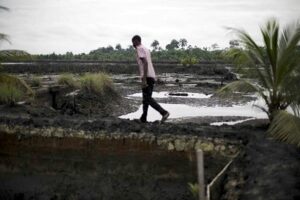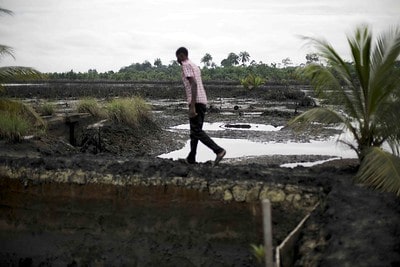5 Effects of Land Pollution Explained
Effects of land pollution are; facilitation of climatic, lithic and hydrological hazards (like climate change, severe erosion and flooding), facilitation of water and air pollutions, soil infertility and food insecurity, biodiversity-loss for both aquatic and terrestrial species, and human health problems.
They can be broadly categorized into; effects of land pollution on environment, human health, plants and animals respectively.
This study discusses the effects of land pollution, as outlined below;
-Effects of Land Pollution on Environment
-Effects of Land Pollution on Plants and Animals
-Effects of Land Pollution on Human Health
-Effects of Land Pollution on Environment
Effects of land pollution on environment are; hazard facilitation, water and air pollution, as well as soil infertility.
1). Facilitation of Climatic, Lithic and Hydrological Hazards (as one of the Effects of Land Pollution)
Land pollution can facilitate the occurrence of multiple environmental issues and hazards.
Examples of hazards facilitated by land pollution are; climate change, severe erosion, flooding, desertification and drought.
Land pollution contributes to climate change in various ways, including the reduction of carbon sequestration rates, and the volatilization of land-pollutants that act as greenhouse gases and cause global warming.
Lithic hazards like drought, severe erosion and desertification can all occur when soil loses its structural integrity and fertility in the wake of land pollution.
Hydrological hazards like flooding may also result from changes in the water retention characteristics of soil in degraded coastal or riverine areas.

2). Facilitation of Water and Air Pollutions
As stated in section (2) above, land pollution can extend its effects beyond the land or lithosphere; into other environmental zones like the hydrosphere and atmosphere.
Land pollution facilitates the occurrence of water and air pollutions because many pollutants that are deposited on the Earth's surface have motile characteristics.
These characteristics imply that these pollutants are not eternally restricted to the point where they have been deposited, but are rather highly capable of migrating beyond this zone to other points in space.
Adjacent water bodies or reserves (natural, artificial) can be affected when pollutants from degraded lands migrate into them. This can occur spontaneously, under the influence of gravity, or by active leaching due to precipitation. The ultimate outcome is induced water pollution.
In similar manner, air pollution can result from degraded lands especially in cases involving significant concentrations of volatile pollutants which can easily be vaporized and transformed to airborne toxins.
Induced air and water pollution from land pollution, can both occur in a scenario like severe land-based oil spillage; which releases low-density, low-boiling point hydrocarbon pollutants into soil. Such pollutants can migrate with relative ease into groundwater and surface water bodies; and could also evaporate to become air-borne.
Land pollution by indiscriminate dumping and unsanitary landfilling can also lead to water and air pollutions. Leachate produced from biodegradation of organic waste in landfills, can migrate into water bodies to cause their degradation [4].
Gases emitted as waste decomposes on land, can also cause air pollution.

3). Soil Infertility and Food Insecurity (as one of the Effects of Land Pollution)
Land pollution makes the soil infertile in many instances, because it can directly alter the physicochemical characteristics of soil.
The effect of land pollution on soil fertility can be attributed to chemical reactions that occur between minerals in the soil, and foreign materials that are introduced into a given land area in the process of pollution.
These reactions can cause considerable changes to occur, so that natural recycling pathways that help with soil conservation and sustainability, are often compromised.
Examples of such pathways and processes are carbon cycles, oxygen cycles, carbon sequestration and biodegradation, among others. Because these concepts help sustain the soil structure, nutrients, organisms and fertility, their alteration due to the presence of pollutants, will invariably cause fertility degradation.
Land pollution affects and reduces soil fertility by changing the structure, aeration, species richness, biodiversity, and physicochemistry of the soil. The term 'physicochemistry' here covers multiple characteristics including temperature, pH, salinity, and nutrient concentrations.
These changes go a long way to alter the role which affected lands can play in sustenance of the biotic and abiotic equilibrium of the ecosystem. By losing its fertility, soil in degraded lands becomes less capable of supporting crop growth. This is the reason why land pollution is linked to food insecurity [5].
Land pollution affects food security in a negative manner, by reducing the biological productivity of affected areas.
Ironically, this often happens as a result of agricultural activities that are not sustainable; including overgrazing and intensive farming with excessive soil-tillage and chemical (fertilizer, herbicide, pesticide) application [2].
Food insecurity by land pollution is a major problem that increases the risk of hunger and socioeconomic collapse in many parts of the world. One of the highly recommended solutions to land pollution within the context of this problem, is sustainable farming.
In addition to affecting the environment, soil infertility and food insecurity from land pollution may also affect human health, by causing deficiency ailments from food inaccessibility.
-Effects of Land Pollution on Plants and Animals
Effects of land pollution on plants and animals mainly revolve around biodiversity loss and decline in organic survival.
4). Biodiversity Loss
One of the effects of land pollution on the ecosystem is loss of biodiversity, which can be traced directly to the decline in degraded soils' capacity to support life.
Land pollution causes biodiversity loss by disrupting the natural flow or trend of food chains, energy pyramids and other important ecologic concepts and parameters.
The ability of land pollution to reduce biodiversity can be inferred from other discussions such as food insecurity in degraded land areas.
Land pollution reduces soil fertility, while increasing toxicity. The outcome of this is a situation whereby plant growth in the soil declines considerably.
Since plants are autotrophs that use solar energy to produce biomass and bioenergy for the entire ecosystem [3], a decline in their diversity and population size, will invariably lead to a decline in the diversity and population-size of the entire ecosystem.
The severity of biodiversity decline by land pollution is vivid in cases where terrestrial ecosystems like forests are encroached upon and degraded by human activities. This is because such ecosystems rely heavily on a robust plant community and healthy soil, for their sustenance.
Aquatic ecosystems like streams and marine zones can also be significantly impacted when the effects of land pollution spill over into these systems.
Such instances can be observed in the form of oceanic plastic pollution (or other forms of ocean pollution); as well as in eutrophication of water bodies due to excessive buildup of nutrients and organic compounds leached and transported into the water from adjacent degraded lands.
-Effects of Land Pollution on Human Health
The effects of land pollution on human health are mainly ailments like; cholera, cardiovascular disease, diarrhea, kidney and liver ailments, dermatitis, skin and lung cancer.
5). Human Health Problems (as one of the Effects of Land Pollution)
One of the effects of land pollution on humans is disease outbreak.
Land pollution causes human health problems because of the close and continuous interaction which humans have with the exposed Earth surface in the course of daily living.
Health problems may result from land pollution through direct physical contact with degraded soils, by exposure to airborne pollutants that have vaporized from the land, or in the course of feeding.
These ailments range from skin disorders by dermal exposure to land pollutants, to respiratory and gastrointestinal illnesses from inhalation and ingestion of toxins from vaporized land pollutants and poisoned food materials respectively.
Examples of the human diseases caused by land pollution are; skin and lung cancer [1], cardiovascular disease, diarrhea, cholera, kidney and liver ailments, acne and dermatitis; among others.

Conclusion
Effects of land pollution are;
1. Facilitation of Climatic, Lithic and Hydrological Hazards
2. Facilitation of Water and Air Pollutions
3. Soil Infertility and Food Insecurity
4. Biodiversity Loss
5. Human Health Problems
References
1). Gatti, C. R.; Di Paola, A.; Monaco, A.; Velichevskaya, A.; Amoroso, N.; Bellotti, R. (2023). "The spatial association between environmental pollution and long-term cancer mortality in Italy." Sci Total Environ. 2023 Jan 10;855:158439. Available at: https://doi.org/10.1016/j.scitotenv.2022.158439. (Accessed 5 May 2023).
2). Gupta, G. S. (2019). "Land Degradation and Challenges of Food Security." Review of European Studies, Canadian Center of Science and Education, vol. 11(1), pages 1-63. Available at: https://ideas.repec.org/a/ibn/resjnl/v11y2019i1p63.html. (Accessed 5 May 2023).
3). Hall, C. A. S. (2014). "Ecosystems and Energy: History and Overview." Reference Module in Earth Systems and Environmental Sciences. Available at: https://doi.org/10.1016/B978-0-12-409548-9.09058-8. (Accessed 5 May 2023).
4). Parvin, F.; Tareq, S. M. (2021). "Impact of landfill leachate contamination on surface and groundwater of Bangladesh: a systematic review and possible public health risks assessment." Appl Water Sci. 2021;11(6):100. Available at: https://doi.org/10.1007/s13201-021-01431-3. (Accessed 5 May 2023).
5). Pozza, L.; Field, D. J. (2020). "The science of Soil Security and Food Security." Available at: https://doi.org/10.1016/j.soisec.2020.100002. (Accessed 5 May 2023).



